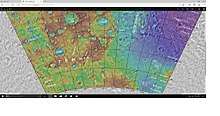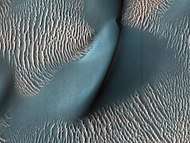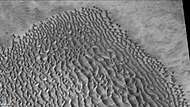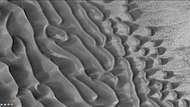Proctor (Martian crater)
|
Proctor Crater Ripples and Dunes, as seen by HiRISE. | |
| Planet | Mars |
|---|---|
| Region | Noachis Terra |
| Coordinates | 48°00′S 330°30′W / 48°S 330.5°WCoordinates: 48°00′S 330°30′W / 48°S 330.5°W |
| Eponym | Richard A. Proctor, a British astronomer (1837–1888) |
Proctor is a large crater in the Noachis quadrangle of Mars, located at 48° south latitude and 330.5° west longitude. It measures 168.2 kilometres (104.5 miles) in diameter and was named after Richard A. Proctor, a British astronomer (1837–1888).[1]
Nearby prominent craters include Rabe to the northeast, Matara to the southeast and the larger Kaiser to the west. East of the crater are Hellespontus Montes.
Dune fields
The crater contains a 35 x 65 km dark dune field.[2][3] It was one of the first sand dune fields ever recognized on Mars based on Mariner 9 images.[4] The crater's dunes are being monitored by HiRISE to identify changes over time.[5]
Barchans
When there are perfect conditions for producing sand dunes, steady wind in one direction and just enough sand, a barchan sand dune forms. Barchans have a gentle slope on the wind side and a much steeper slope on the lee side where horns or a notch often forms.[6] The whole dune may appear to move with the wind. Observing dunes on Mars can tell us how strong the winds are, as well as their direction. If pictures are taken at regular intervals, one may see changes in the dunes or possibly in ripples on the dune’s surface. On Mars dunes are often dark in color because they were formed from the common, volcanic rock basalt. In the dry environment, dark minerals in basalt, like olivine and pyroxene, do not break down as they do on Earth. Although rare, some dark sand is found on Hawaii which also has many volcanoes discharging basalt.
Barchan is a Russian term because this type of dune was first seen in the desert regions of Turkistan.[7]
Some of the wind on Mars is created when the dry ice at the poles is heated in the spring. At that time, the solid carbon dioxide (dry ice) sublimates or changes directly to a gas and rushes away at high speeds. Each Martian year 30% of the carbon dioxide in the atmosphere freezes out and covers the pole that is experiencing winter, so there is a great potential for strong winds.[8]
 Topographical map showing location of Proctor Crater and other nearby craters
Topographical map showing location of Proctor Crater and other nearby craters HiRISE image of the crater
HiRISE image of the crater The edge of a dark dune field on the floor of Proctor Crater
The edge of a dark dune field on the floor of Proctor Crater Dune field on floor of Proctor Crater, as seen by CTX camera on Mars Reconnaissance Orbiter.
Dune field on floor of Proctor Crater, as seen by CTX camera on Mars Reconnaissance Orbiter. Close-up of dunes on floor of Proctor Crater, as seen by CTX camera on Mars Reconnaissance Orbiter. This is an enlargement of part of previous image.
Close-up of dunes on floor of Proctor Crater, as seen by CTX camera on Mars Reconnaissance Orbiter. This is an enlargement of part of previous image.
See also
References
- ↑ "Gazetteer of Planetary Nomenclature | Proctor". usgs.gov. International Astronomical Union. Retrieved 4 March 2015.
- ↑ Fenton, L. K. (2005). "Seasonal Movement of Material on Dunes in Proctor Crater, Mars: Possible Present-Day Sand Saltation" (PDF). Lunar and Planetary Science XXXVI (2005).
- ↑ Mary Chapman, ed. (2007). The Geology of Mars: Evidence from Earth-Based Analogs. Cambridge University Press. p. 250. ISBN 978-0-521-83292-2.
- ↑ "Dune Activity in Proctor Crater". Mars Global Surveyor - Mars Orbiter Camera - MGS MOC Release No. MOC2-170. Malin Space Science Systems. 10 August 1999.
- ↑ Bridges, Nathan (9 March 2009). "Sand Dunes and Ripples in Proctor Crater". HiRISE Operations Center.
- ↑ Pye, Kenneth; Haim Tsoar (2008). Aeolian Sand and Sand Dunes. Springer. p. 138. ISBN 9783540859109.
- ↑ http://www.britannica.com/EBchecked/topic/53068/barchan
- ↑ Mellon, J. T.; Feldman, W. C.; Prettyman, T. H. (2003). "The presence and stability of ground ice in the southern hemisphere of Mars". Icarus. 169 (2): 324–340. Bibcode:2004Icar..169..324M. doi:10.1016/j.icarus.2003.10.022.
External links

Related articles
- Nemiroff, Robert; Bonnell, Jerry (February 26, 2002). "Sand Dunes on Mars". Astronomy Photo of the Day (APOD).